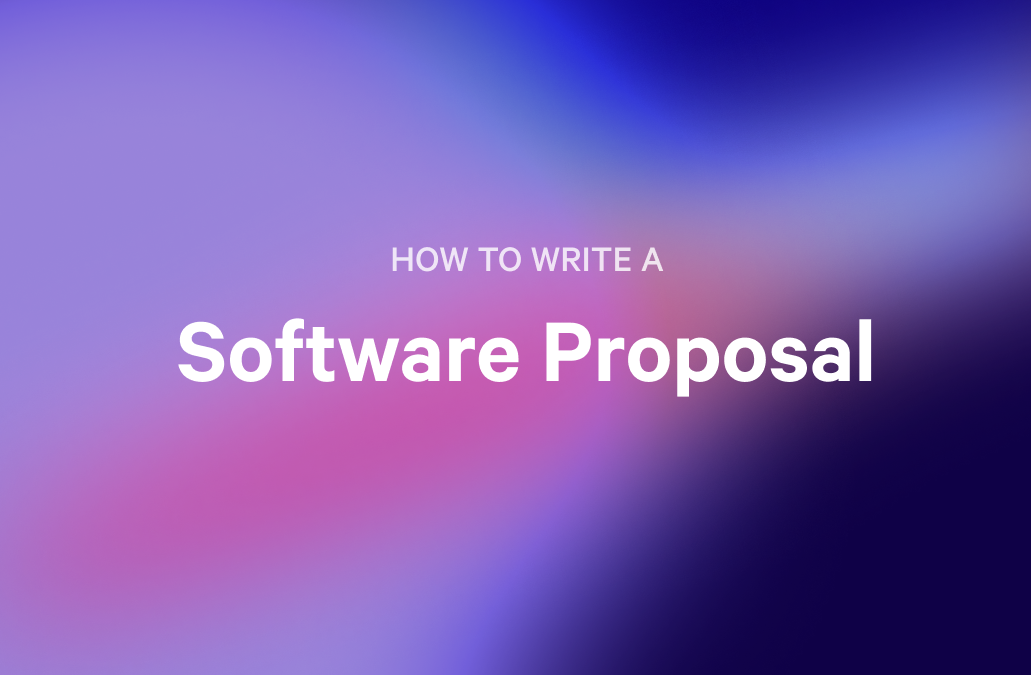Whether you’re a grizzled veteran or just starting out, writing a copywriting proposal can be challenging! Even if you write the most compelling copy for the biggest brands (or some serious up-and-comers), creating a proposal explaining why someone should hire you is a unique challenge that can be daunting to even the most successful pros.
Writing a good proposal isn't just about listing what you can do; it's about connecting with your potential client. It's about showing them you understand their needs and that your services fit them perfectly.
In this article, we'll look at the essential components of a good proposal and walk you through how to make your offer engaging and effective.
So, let's get started on making your first impression a lasting one…
What is a copywriting proposal?
A copywriting proposal is, essentially, a sales proposal that outlines what you, the freelance copywriter (or agency), can offer the client. However, it goes beyond this surface-level transactional function: it is the key to building a relationship with a new (or prospective) client.
A great copywriting proposal shows you are not just another copywriter or agency in a crowded field. It shows that you deeply understand their business, target audience, and how to speak to them. It links your very specific skills and services to their very specific needs. This is the cornerstone of all successful sales methodologies.
For a better idea of what this entails, look at our Copywriting Proposal Template.
Steps to writing a copywriting proposal: Key elements to include
In this section, we'll go through the crucial steps to create a sales proposal that showcases your talents and speaks to your clients.
1. Conduct research to understand your prospect's needs
Start by thoroughly researching your client's business. Familiarize yourself with their story, their competitors, and their position in the market. This will help determine how your text can set you apart from the competition.
Look at their current content. What style and tone of voice do they use? Your job is to show you can work with and even enhance their voice while staying within their brand guidelines.
Next, you should focus on the target audience. Who are they trying to reach? Find out about the target group's needs, wishes, and habits. Your offer must show how your writing will speak to, not at, these people, to get the desired reaction.
And finally, on that note, it’s vital to understand the customer's goals and what that “desired reaction” is. Whether it's to increase sales, build the brand, or inform the target group, it should be clear from your offer how your text will help the customer achieve these goals.
2. Define the scope of work
In this part of your proposal, you'll define what you can and will do as part of your engagement. You need to be clear, specific, and flexible enough to adapt.
Start by listing the exact services you'll offer. Web copy for a new site? Custom landing pages? Blog or news content? Social media? Email marketing? Describe precisely what you'll be writing and where it will be used. Then, talk about how much work you'll be doing. How many pieces of content will you write, and in what timeframe? In addition to outlining the content, you'll create, list any additions you can provide or exclusion of things you won't. These could include SEO services, image sourcing or editing, additional rounds of revision, content scheduling or uploading, or analytics.
Being very detailed about the scope of work and timeline aligns client expectations from the start and makes managing the project easier for both parties.
3. Outline your strategy and approach
In this part of your proposal, you will explain in detail how you will help your prospect achieve their goals.
Start with your first steps. How will you start the project? Describe your research process and how you gather information. This may include learning more about the client's industry, doing competitive analysis, interviewing subject matter experts or stakeholders, and getting to know their audience. It's essential to show that you've got a process to thoroughly prepare to write excellent copy.
Then, talk about how you will match the voice of your client's brand. Your copy must reflect the client's style and values. Explain how you'll strike the right tone -- even if the client doesn't have a fully developed set of brand guidelines or voice and tone.
Next, discuss your plan for the content itself. How will you address the target audience? You could tell stories, share data and insights, or provide thought leadership. This is where you can show you understand different ways to engage and persuade your audience.
And don’t forget to mention any unique skills you bring to the table, too. For example, any content strategy, SEO expertise, or project management skills that can help distinguish your proposal.
4. Set clear objectives and goals
This section is crucial because it's where you show how your content will help your prospect achieve their goals. Will your content be used to drive more visits to the website, increase sales, raise brand awareness, or improve the customer experience?
It's important that you know exactly what your client's goals are and the part your work plays in their over-arching strategy and business objectives.
Make these goals quantifiable, too. For example, don't just say you want to "increase web traffic." Instead, set a clear goal like "boost web traffic by 20% in the next six months." This level of detail gives you both a solid benchmark against which to measure your success.
You should also discuss how you'll track and measure success. Will you use website analytics, customer surveys, or sales figures? If you're clear about this, it shows that you're results-oriented, invested, and accountable.
5. Provide a Timeline
Here, you lay out a clear plan for the timeline and steps of the project. Start by dividing the project into different phases. For instance, you could have one phase for initial research, one for content creation, and one for edits or revisions.
Dividing the project in this way makes it easier to manage. It also gives the client a good idea of your work process and what happens at each part of the project.
For each phase, you should estimate how long it will take. Be honest and practical. Think about how long it usually takes you to do similar work. Remember to allow extra time for client feedback and making any necessary changes.
It's also important to be flexible with your schedule. It's good to have clear deadlines, and a contingency for the unexpected is prudent, too. Tell your client that you are willing to change the schedule if necessary -- and how much notice would be required for you to do so.
In addition to the different phases of the project, you should also indicate all critical milestones and deadlines. This is especially important if the project is linked to specific events or deadlines, such as product launches or marketing campaigns.
6. Include your pricing details
It's essential to make your pricing table as clear as possible. You want your clients to understand what they're paying for without having to dig through the fine print!
Start by listing every service you plan to offer as part of this proposal. Instead of giving one hefty price for the entire engagement, you can break it down. Show the cost of the different parts, such as research, writing, and editing.
Next, you should talk about how you set your prices. Do you charge hourly, per word, or a fixed amount per piece or project? Choose the method that suits your working style and is easy for your clients to understand.
Be upfront about any additional costs that might apply, such as fees for rush jobs, additional rounds of revisions or additional services like sourcing images or uploading content into their CMS. This might help your potential clients see that you can take additional work off of their plates, and the honesty will help build client trust. Your prospects will appreciate knowing all of the associated costs upfront.
7. Showcase your credentials and highlight your experience
In your proposal, it is important to talk about your background and achievements related to your copywriting skills. A professional yet personable tone is usually best for this part of the proposal.
Start by discussing your work history, especially the jobs most closely related to your proposed project. Have you worked in similar fields or faced similar challenges? These are the case studies and experiences your potential client wants to hear about. Use data to back up your experience and avoid an unsubstantiated claims.
Once you've explained your work history, move on to your special skills and prominent successes. Maybe you helped a previous client increase traffic to their website? Or did you write the copy for a campaign that went viral? These achievements show that the skills you have been highlighting throughout your proposal lead to tangible results and a return on your clients investments.
Finally, never forget the power of social proof when selling! If you have good reviews or recommendations from people you've worked with, make sure you include these, too. They can help you close the deal and win the business.
8. Personalize and proofread
When writing a copywriting proposal, it's essential to keep it personalized. Using your prospect's name is a good place to start, but you'll want to add more personal touches. That way it doesn't look like you're firing off a generic proposal created by copying a proposal template (even if you are).
Take a little time to talk about the customer's business in your offer. Mention something that makes the company special, something great they've done recently, or a challenge they're facing. A few Google searches or a tour of their LinkedIn business page should surface something good for you to work in quickly.
Then, make sure you relate your services to the company's needs. Don't just list what you offer. Explain how your services can help with their problems. This clarifies that you've considered their needs and not just pitched a standard one-size-fits-all service. You're selling a solution.
Proofreading is just as important as personalization, especially if you're trying to show off your strong copywriting skills. A client proposal with a typo would be embarrassing. If your offer contains spelling or grammatical errors, it will damage your first impression- not to mention fatally undermine any claims you’ve made about your attention to detail.
When you're done, you might want to take a short break, and walk away from your computer for a bit. Then, read through your proposal several times, preferably out loud. Reading out loud is a great way to pick out errors that can slip through when you just check it in your head.
Example: Copywriting Proposal Template
Even with the help of this guide, a copywriting proposal template can be useful to speed up your sales process. The best proposal templates provide a clear structure, ensure nothing is left out, and save you time that you can spend crafting better, and more personal messaging.
At Qwilr, we offer a free proposal template for creating winning copywriting proposals. Here's what's inside:
- Executive Summary: This is where you grab attention. Briefly explain to prospective copywriting clients what you're offering and give them a taste of what's to come.
- Client Challenges: Here, you talk about the problems your client has. You're acknowledging the hurdles in their way and showing that you understand them and are well positioned to help.
- Your Experience in Handling These Challenges: In this part, you can prove your skills. Tell them about similar problems you have already solved, assuring them that you've been down this path before and know how to succeed.
- Testimonials: Alongside proven results, the power of a previous customer's good words goes a long way.
- Our Process: Explain the steps you'll take for the project. Share the roadmap you’ve drawn for your success together.
- Project Scope: Be very clear about what your services include, and what they don't
- Investment: This is no time to be coy: talk about the cost. It is important to be open and clear about your pricing and show the client what they're getting for their money.
- Our Team: Introduce the people who'll be working on the project (if applicable) or share your own bio.
- CTA (Call to Action): Finish by inviting your potential customer to take the next step. Whether it's scheduling another meeting, requesting a contract, or signing on the dotted line, it's a friendly push, encouraging them to move forward with you.
Alternatively, you can try our AI proposal generator for free and create your own professional looking proposal in minutes.
Key takeaways for writing successful copywriting proposals
The key to a winning proposal lies in understanding your customer's needs and presenting your offer in a concise and informative way. “I understand your problem. Here is how I will solve it”.
Using a template can help speed up the process and ensure that you don't skip any of the critical steps or leave out key details.
We hope this guide has helped you understand what should be included in your proposal and provided a solid framework for creating a template that helps you win consistently. If you want even more help grab our Copywriting Proposal Template to simplify the process and let you focus on your real strength – creating compelling content that delivers results.
About the author

Marissa Taffer|Founder & President of M. Taffer Consulting
Marissa Taffer is the Founder & President of M. Taffer Consulting. She brings over 15 years of sales and marketing experience across various industries to a broad range of clients.
Frequently asked questions
The ideal format for a copywriting writing proposal should be simple and well-organized. Whether you're writing in a Google or Word doc or using proposal management software, opt for a structure that covers the most essential points. These include a brief overview of your services, your previous work and achievements, testimonials from previous clients, and a clear overview of the project and costs. This way, your proposal will be thorough and easy for the prospective client to understand, which can kickstart a good working relationship.
There are no hard-and-fast rules here. A solid copywriting client proposal is usually around five pages long. This length provides a balance that ensures the proposal is informative and thorough but not overwhelming.


